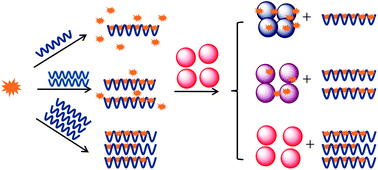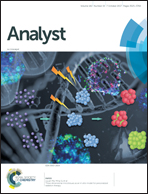A luminescent and colorimetric probe based on the functionalization of gold nanoparticles by ruthenium(ii) complexes for heparin detection†
Abstract
A sensitive assay was demonstrated for the colorimetric and luminescent detection of heparin. Positively charged [Ru(phen)2np]2+ (np: naphtho[2,3-f][1,10]phenanthroline) can interact with negatively charged AuNPs through electrostatic interaction, leading to the luminescence quenching of [Ru(phen)2np]2+via energy transfer as well as the aggregation of AuNPs together with a color change in solution from red to blue. Upon the addition of negatively charged heparin to gold nanoparticles functionalized by ruthenium(II) complexes, the emission of [Ru(phen)2np]2+ recovered due to the competitive adsorption of [Ru(phen)2np]2+ to heparin and AuNPs. A linear calibration curve was obtained in the 0.4 μM to 100 μM range and 0.1 μM to 6 μM with a low detection limit of 0.22 μM and 0.024 μM based on 3σ/s for heparin quantification in buffer solution and in 1% fetal bovine serum (FBS), respectively. Interestingly, the naked eye alone can judge the presence of 0.02 μM heparin without the aid of any advanced instruments by color change. Thus a convenient and visual method to detect heparin was established.



 Please wait while we load your content...
Please wait while we load your content...